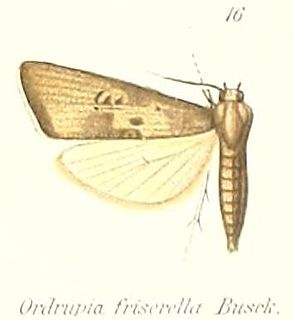
Copromorphidae, the "tropical fruitworm moths", is a family of insects in the lepidopteran order. These moths have broad, rounded forewings, and well-camouflaged scale patterns. Unlike Carposinidae the mouthparts include "labial palps" with the second rather than third segment the longest. With other unusual structural characteristics of the caterpillar and adult, it could represent the sister lineage of all other extant members of this superfamily. The genus Sisyroxena from Madagascar is also notable for its unusual venation and wing scale sockets.

Microniinae is a subfamily of the lepidopteran family Uraniidae.
Idiophantis is a genus of moths in the family Gelechiidae.

Halone is a genus of moths in the subfamily Arctiinae from southern Asia and Australia. The genus was erected by Francis Walker in 1854.
Parelictis is a monotypic moth genus in the subfamily Arctiinae. Its only species, Parelictis saleuta, the mottled footman, has been recorded from the Australian states of New South Wales and Victoria. Both the genus and species were first described by Edward Meyrick in 1886.
Tylanthes is a monotypic moth genus in the subfamily Arctiinae. Its only species, Tylanthes ptochias, is found in Australia and New Guinea. It is found in both lowland and highland habitats. Both the genus and species were first described by Edward Meyrick in 1889.
Macaretaera is a monotypic moth genus of the family Crambidae described by Edward Meyrick in 1886. It contains only one species, Macaretaera hesperis, described by the same author in the same year, which is found in India, Vietnam, Australia (Queensland), Papua New Guinea and on Fiji.
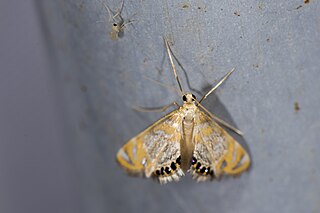
Nymphicula is a genus of moths of the family Crambidae.
Amata cyanura is a species of moth of the family Erebidae first described by Edward Meyrick in 1886. It is found on the Torres Strait Islands between Australia and New Guinea.
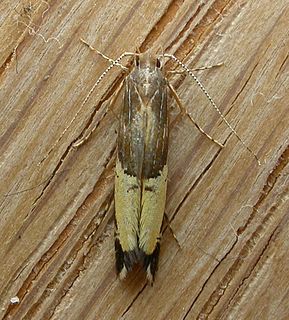
Labdia is a genus of moths in the family Cosmopterigidae.

Macrobathra is a genus of moths in the family Cosmopterigidae. Most species are endemic to Australia.

Tiquadra is a genus of moths belonging to the family Tineidae.
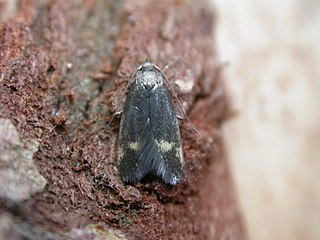
Borkhausenia is a genus of the concealer moth family (Oecophoridae) described by Jacob Hübner in 1825. Among these, it belongs to subfamily Oecophorinae, wherein it is probably closely related to Hofmannophila. In the past, several other Oecophoridae have been included in Borkhausenia, as well as a few even more distant members of the superfamily Gelechioidea. Metalampra was originally described as a subgenus of Borkhausenia. Telechrysis has also been included here as a subgenus by some, while other authors have considered it a separate genus in the Oecophorinae or – if these are also considered distinct – the Amphisbatinae.
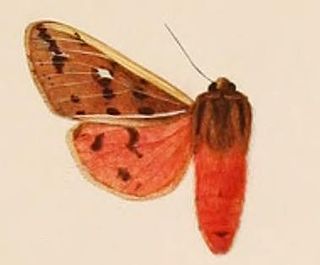
Spilaethalida is a genus of moths in the family Erebidae from New Guinea and Northern Australia. One undescribed species occurs in Sulawesi.
Cyme pyraula is a moth of the family Erebidae first described by Edward Meyrick in 1886. It is found in the Australian state of Queensland and on New Guinea.

Gracillariinae are a subfamily of moths which was described by Henry Tibbats Stainton in 1854.
Ceryx sphenodes is a moth of the subfamily Arctiinae. It was described by Edward Meyrick in 1886. It is found in New Guinea and Queensland, Australia.
Cryptolechia is a genus of moths in the family Depressariidae.
Kertomesis is a moth genus in the family Autostichidae.

Tingena is a genus of the concealer moth family (Oecophoridae). This genus is endemic to New Zealand.











